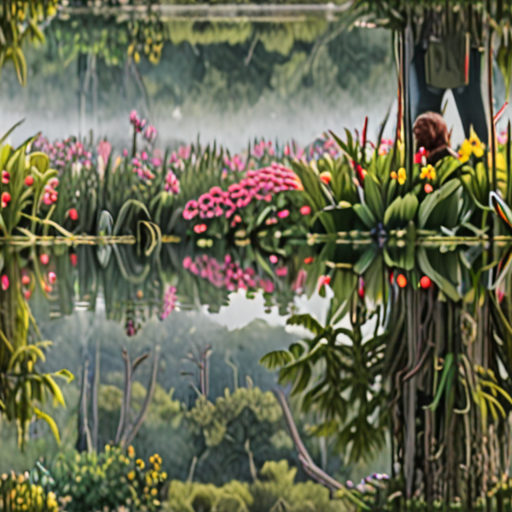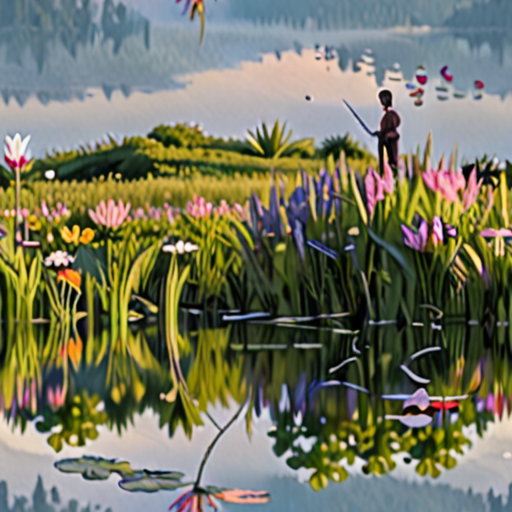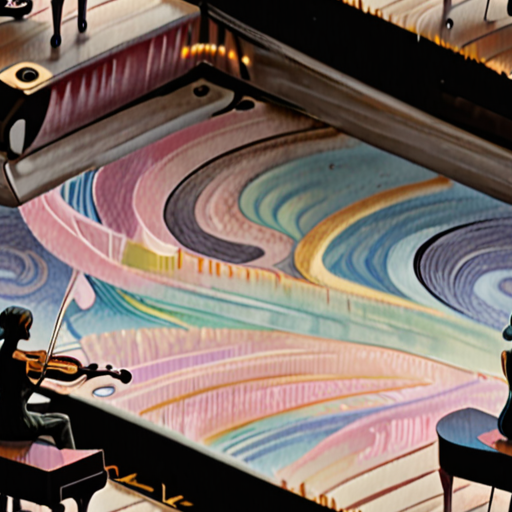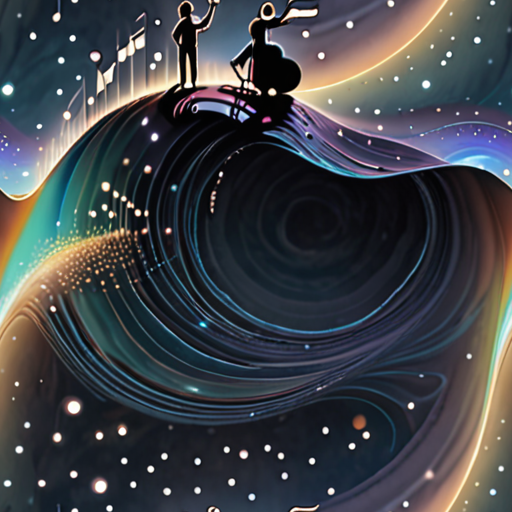Music has long been considered a universal language, capable of evoking emotions, conveying ideas, and bringing people together like nothing else can. At its core, artistic reflection in music is about tapping into this power, using creative expression to convey the depths of human experience. From the soaring melodies of classical compositions to the improvisational genius of jazz, every genre of music offers a unique window into the artist’s soul. But what exactly makes music an art form? And how do different styles and genres reflect the artistic values that underlie them? In this exploration of the intersection of music and art, we’ll delve into the world of musical arts, examining the ways in which music reflects our shared humanity and the role it plays in shaping our understanding of ourselves and the world around us.

Artistic Expression in Music
As a musician, I believe that artistic expression in music is the ability to convey emotions, thoughts, and experiences through sound.
- Dynamics: Using varying levels of loudness and softness to create contrast and emphasize certain parts of the music.
- Phrasing: Grouping notes together to create a sense of rhythm and melody.
- Timbre: Using different tones and textures to create a unique sound.
- Articulation: Controlling the attack and release of notes to create a specific feel.
When I’m performing, I try to tap into my own emotions and experiences to bring authenticity to the music. It’s about connecting with the audience on a deeper level and creating a shared experience.
The Importance of Authenticity
Authenticity is key to conveying artistic expression in music. When I’m true to myself and my emotions, the music feels more genuine and relatable.
- I draw inspiration from my own life experiences and emotions.
- I experiment with different sounds and techniques to find what works best for me.
- I take risks and push boundaries to create something new and original.
Connecting with the Audience
As a musician, I want to connect with my audience on a deeper level. I believe that music has the power to transcend borders and cultures, bringing people together in a shared experience.
- I engage with my audience through social media and live performances.
- I share my story and inspirations to create a connection with my listeners.
- I collaborate with other artists to create something new and exciting.
Conclusion
Artistic expression in music is about tapping into our own emotions and experiences to create something authentic and meaningful. By embracing our individuality and taking risks, we can create music that resonates with others and brings us closer together.
Understanding Artistic Value in Music
Artistic value in music refers to the unique qualities that make a piece of music aesthetically pleasing, emotionally resonant, and intellectually stimulating. As a fan of indie music, I’ve always been fascinated by the ways in which artists convey meaning and emotion through sound. In this article, we’ll delve into the concept of artistic value in music and explore its various aspects.
The Role of Beauty in Music
Beauty is often considered the primary artistic value in music. It encompasses the sonic qualities that evoke emotions, create atmosphere, and engage listeners on a deeper level. From the soaring melodies of indie rock to the intricate harmonies of chamber music, beauty is a fundamental aspect of music that transcends genre boundaries.
- Musical beauty can take many forms, including melody, harmony, rhythm, and timbre.
- It’s often subjective, relying on individual tastes and preferences.
- However, certain musical elements, such as resolution and contrast, can contribute to a sense of beauty regardless of personal taste.
Emotional Resonance and Authenticity
Beyond beauty, music’s artistic value lies in its ability to evoke emotions and create connections with listeners. Authenticity plays a crucial role in this process, as audiences respond to genuine expressions of feeling and experience. Indie music, in particular, has thrived on its emotional intensity and vulnerability, allowing artists to share their inner worlds with a receptive audience.
- Authenticity fosters trust between artist and listener, making the music more relatable and impactful.
- Emotional resonance can be achieved through lyrics, melody, or instrumental textures, depending on the artist’s vision.
- By tapping into universal human experiences, music can transcend cultural and linguistic barriers, speaking to our shared humanity.
Creativity and Originality
Artistic value in music also involves creativity and originality, as artists push boundaries and challenge conventions. By experimenting with new sounds, styles, and themes, musicians can create innovative works that resonate with listeners and leave a lasting impact.
- Creativity can manifest in various ways, such as incorporating unconventional instruments or exploring new production techniques.
- Originality is essential for standing out in a crowded musical landscape and attracting attention from critics and fans alike.
- By embracing risk-taking and innovation, artists can redefine the possibilities of music and inspire future generations.
Conclusion
Artistic value in music encompasses a multifaceted array of qualities, including beauty, emotional resonance, authenticity, creativity, and originality. By understanding these aspects, we can appreciate the complexity and richness of music, recognizing its power to move, inspire, and transform us. Whether you’re a seasoned music enthusiast or just discovering the world of indie music, there’s always something new to explore and cherish in the realm of artistic value.
What is Artistic in Music?
As a fan of indie music, I’ve always been fascinated by what makes music truly artistic.
- For me, it starts with creativity and self-expression – the ability to convey emotions and ideas through sound.
- Artistic music often pushes boundaries and challenges conventional norms, inviting listeners to think differently and feel deeply.
- It’s about crafting a unique sonic landscape that transports us to another world, evoking feelings and memories we thought were long forgotten.
The Power of Artistic Music
When music is truly artistic, it has the power to:
- Movate us emotionally, connecting us to our deepest desires and fears.
- Challenge our perspectives, broadening our understanding of the world around us.
- Bring people together, fostering a sense of community and shared experience.
Indie Music and the Artistic Spirit
Republic of Wolves is a testament to the artistic spirit of indie music, showcasing the creative journeys of bands and artists who refuse to conform to mainstream expectations.
- We celebrate the raw emotion and vulnerability that defines true artistry.
- We highlight the innovative production techniques and experimental approaches that push the boundaries of sound.
- We share the stories behind the music, giving voice to the artists and their experiences.
Exploring the Artistic in Music
Whether you’re a seasoned music lover or just discovering the world of indie sounds, there’s always something new to explore and discover.
- From the haunting melodies of ambient electronica to the driving rhythms of post-punk revival, every genre offers a unique window into the artistic soul.
- By embracing the unknown and the unconventional, we can tap into the raw energy and creativity that defines artistic music.
- So let’s embark on this musical journey together, exploring the depths of human emotion and the infinite possibilities of sound.

The Meaning of Musical Arts
As someone who’s passionate about music, I’ve always been fascinated by the concept of musical arts. In my opinion, the term musical arts encompasses the study and practice of musical theory and performance, which involves understanding the fundamental principles of music, as well as developing skills to express oneself through various forms of music-making.
Defining Musical Arts
Musical arts can be broken down into several key components, including:
- Composition: The process of creating original music, involving melody, harmony, rhythm, and other elements.
- Performance: The act of interpreting and presenting composed music, whether solo or ensemble, through various instruments or vocal techniques.
- Improvisation: The ability to create music spontaneously, often in response to a particular situation or mood.
- Music Theory: The study of the underlying structures and concepts that govern music, including notation, harmony, and analysis.
The Importance of Musical Arts
Understanding and appreciating musical arts has numerous benefits, including:
- Cognitive Development: Studying music theory and composition can enhance cognitive abilities, such as memory, spatial-temporal skills, and language development.
- Emotional Expression: Music-making allows individuals to convey emotions and tell stories, fostering empathy and self-awareness.
- Social Connection: Participating in musical activities can bring people together, promoting social bonding and community engagement.
- Cultural Enrichment: Exploring diverse musical traditions and styles can broaden cultural understanding and appreciation.
Exploring Musical Arts
If you’re interested in exploring musical arts further, consider the following resources:
- Indie Musician : A platform offering tips, tutorials, and inspiration for independent musicians.
- Music Theory Net : An online resource providing music theory lessons, exercises, and quizzes.
- Republic of Wolves : A community dedicated to indie music enthusiasts, featuring articles, interviews, and reviews.
By embracing musical arts, we can deepen our understanding of music, foster creativity, and enrich our lives with the beauty and power of sound.
Music as Art
As a fan of indie music, I often find myself pondering the question of how music can be considered a form of art.
- For me, music is a powerful medium that evokes emotions and sparks creativity.
- When I listen to my favorite bands, I feel a deep connection to the lyrics, melodies, and rhythms that transport me to another world.
- This emotional resonance is what makes music a true work of art – it has the ability to transcend words and touch our souls.
The Creative Process
Republic of Wolves understands the importance of creativity in music-making.
- We believe that every song is a unique expression of the artist’s vision and experiences.
- From the initial spark of inspiration to the final recording, the creative process is a journey of self-discovery and experimentation.
- By embracing this process, artists can tap into their deepest emotions and create something truly original and meaningful.
Indie Music Scene
As a community, we’re passionate about supporting emerging artists and celebrating the diversity of indie music.
- We believe that music has the power to bring people together and foster connections across cultures and borders.
- Through our platform, we aim to showcase talented musicians who are pushing the boundaries of sound and style.
- Whether it’s through live performances, interviews, or behind-the-scenes stories, we want to give fans a glimpse into the lives of these incredible artists.
Conclusion
Music is a universal language that speaks directly to our hearts and minds.
At Republic of Wolves, we’re committed to sharing the beauty and complexity of music with the world.
Join us on this journey of discovery and exploration, and let’s celebrate the magic of music together!

Understanding Performance Art
Performance art encompasses various disciplines, and its core elements play a crucial role in shaping the overall experience. As a fan of indie music, I’m excited to delve into the world of performance art and explore its fundamental components.
The Four Elements of Performance Art
When it comes to performance art, there are four essential elements that come together to create a unique experience. These elements are:
- Time: Time is a critical aspect of performance art, as it dictates the duration and pacing of the event. From the beginning to the end, time influences how the audience engages with the performance.
- Space: Space refers to the physical environment in which the performance takes place. This can range from intimate settings to large-scale installations, each affecting the viewer’s perception and interaction with the artwork.
- Body or Presence in a Medium: The artist’s body or presence in a medium is a vital element of performance art. This can take many forms, including dance, theater, music, or visual arts, and serves as a means of self-expression and communication.
- Relationship Between Performer and Audience: The connection between the performer and the audience is a dynamic and reciprocal process. It’s through this relationship that the artist conveys emotions, ideas, and experiences, ultimately creating a shared understanding between the two parties.
Exploring Performance Art Further
To gain a deeper understanding of performance art, it’s essential to explore its various forms and applications. Some notable examples include:
- Dance and movement-based performances, such as those found in contemporary dance or ballet.
- Theater and spoken word performances, which often incorporate storytelling and dialogue.
- Musical performances, ranging from classical compositions to experimental soundscapes.
- Visual arts and installation performances, which may involve interactive or immersive experiences.
Conclusion
In conclusion, performance art is a multifaceted discipline that relies on four fundamental elements: time, space, body or presence in a medium, and the relationship between performer and audience. By understanding these elements and exploring the various forms of performance art, we can appreciate the complexity and richness of this art form. Whether you’re a seasoned artist or simply a curious observer, performance art offers a wealth of inspiration and creativity waiting to be discovered.

0 Comments